Architecture Home Styles
How to Identify Floor Boards in 10 Simple Steps
Intrigued by different floorboards? Uncover the secrets in 10 simple steps that will change how you see your floors forever!

Ever wondered how to distinguish between different types of floorboards effortlessly?
What if I told you there are ten simple steps to help us identify them with ease?
From examining wood grain to checking for knot holes and assessing board lengths, each step holds a key to unraveling the mystery of floorboard identification.
So, why not join us on this journey of discovery and unravel the secrets hidden beneath our feet?
Key Takeaways
- Recognize wood species by unique grain patterns like oak, maple, cherry, and walnut.
- Assess floor solidity through tap tests for stability and condition.
- Measure board thickness accurately for refinishing and durability assessment.
- Examine board edges and nail holes to determine style, age, and installation method.
Step 1: Check for Wood Grain
To begin identifying floor boards, first examine the direction of the wood grain to determine the type of wood used. Different wood species exhibit unique grain patterns that serve as valuable identifiers.
Oak, for instance, often boasts a pronounced grain pattern that's easily distinguishable. The grain of maple, on the other hand, tends to be more subtle and uniform, offering a different visual cue.
Cherry wood presents a fine, straight grain with intermittent waves or curls, providing a distinct look compared to other species. Meanwhile, walnut showcases a deep, rich color accompanied by a straight, fine grain, making it stand out in terms of appearance.
Step 2: Look for Knot Holes

When examining floorboards for knot holes, we focus on their characteristics, types, and locations. Knot holes can vary in shape, size, and frequency, providing unique insights into the wood's grade and style.
Noting these features helps us understand the rustic charm and visual appeal that knot holes bring to wooden flooring.
Knot Hole Characteristics
Knot holes in wood flooring, resulting from branches that were once part of the tree, exhibit unique characteristics that contribute to the floor's overall appearance and charm. These natural imperfections vary in size, shape, and color, enhancing the wood's character.
Small knot holes are commonly filled with epoxy or wood filler during finishing to prevent debris accumulation. Larger knot holes, if left open for a more rustic look, should be secure and not pose tripping hazards. In certain wood flooring grades like Country, knot holes are a sought-after feature, adding visual interest and charm.
Understanding the characteristics of knot holes can help homeowners appreciate the beauty of their wood flooring while ensuring its longevity and safety.
Types of Knot Holes
In examining wood flooring for knot holes, one should carefully observe the variations in size, shape, and color to appreciate the unique character they contribute to the overall aesthetic. Knot holes in wood floors can range from small, charming imperfections to larger voids that may require filling for a smoother surface.
Small knot holes are often embraced in rustic or country-grade wood flooring, enhancing its natural appeal. On the other hand, larger knot holes found in higher-grade wood floors may need to be filled with wood putty or epoxy to maintain a more refined look.
Whether strategically placed for visual interest or left untouched for a rugged charm, the types of knot holes present in wood floors play a significant role in defining their individuality.
Knot Hole Location
Observing the wood flooring closely reveals the intricate locations of knot holes, contributing to the overall aesthetic and quality of the floorboards. Knot holes, natural voids in the wood caused by imperfections like branches, vary in size, shape, and placement on the floorboards.
These unique features enhance the character of the floor, offering a glimpse into the wood's history. Knot holes can be filled with epoxy for a smooth surface or left open for a more rustic appearance, depending on personal preference.
Step 3: Tap for Solid Sound
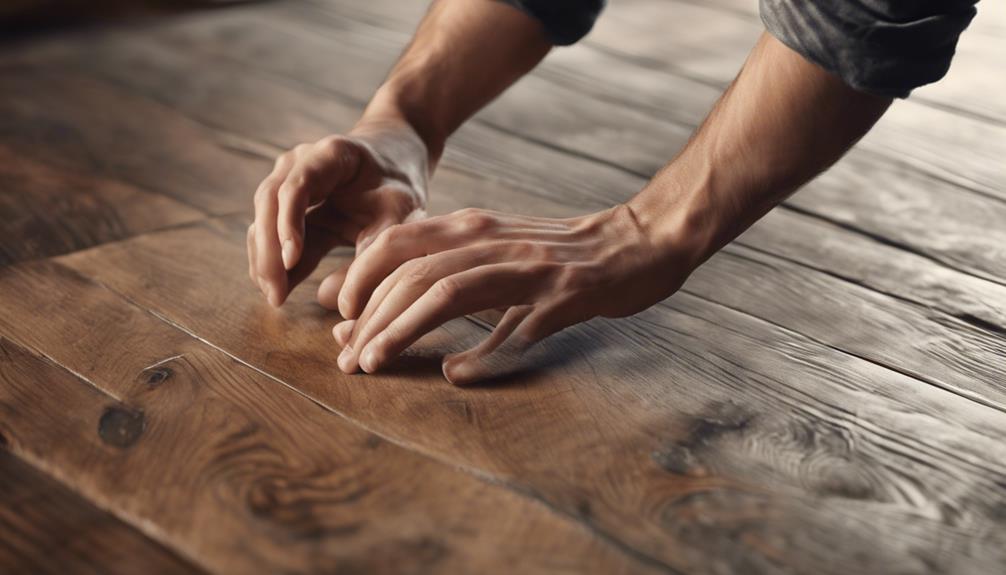
When tapping the floorboards, we employ a sound test method to identify areas of concern.
By listening for resonance, we distinguish between solid and hollow sounds.
The solid tap technique helps determine the stability and condition of the floorboards.
Sound Test Method
Utilizing a hard object like a hammer or the back of a screwdriver, lightly tap the floorboard to assess its solidity through the emitted sound. This simple method can reveal crucial information about the condition of the floorboards in your space.
Here are some key points to consider when conducting the sound test:
- Listen for a solid and consistent sound.
- A hollow or inconsistent sound may indicate loose or damaged floorboards.
- Perform the tap test across different areas of the floor.
- Variations in sound can help pinpoint specific problem areas.
- This quick assessment can guide you in determining maintenance or repair needs promptly.
Listening for Resonance
To identify the resonance of floorboards, lightly tap them and listen for a solid, clear sound that indicates the composition of the wood. Solid hardwood boards will produce a distinct, ringing resonance when tapped due to their dense nature. In contrast, engineered wood boards may yield a hollow or dampened sound, revealing their different composition. This resonance test serves as a valuable method for distinguishing between solid hardwood and engineered wood floorboards without the need for visual inspection. By utilizing this simple tapping technique, you can effectively determine the type of floorboards present in your space.
| Resonance Test Results | Interpretation |
|---|---|
| Clear, Ringing Sound | Solid Hardwood Boards |
| Hollow or Dampened Sound | Engineered Wood Boards |
Solid Tap Technique
In our assessment, we tap the floorboards lightly with a hammer or mallet, listening attentively for a solid, resonant sound. This solid tap technique is crucial when examining hardwood floors for stability and quality.
Here are some key points to consider:
- A solid sound indicates a well-secured and properly installed hardwood floorboard.
- Hollow or dull sounds may signify loose or damaged floorboards that require immediate attention.
- Consistent solid sounds across the hardwood floor suggest a stable and well-maintained flooring system.
- Conducting the tap test can help pinpoint areas in need of repair or reinforcement to ensure a structurally sound hardwood floor.
- Regularly using the solid tap technique can aid in maintaining a durable and reliable hardwood flooring surface.
Step 4: Inspect for Varnish

When examining the floor boards, assess the presence of varnish by looking for a glossy or shiny finish that indicates a protective coating has been applied. Varnish serves as a shield, enhancing the durability and appearance of wood floors. It creates a polished surface with a lustrous sheen, protecting against moisture damage, stains, and wear. Look for a clear or tinted coating that forms a protective barrier on the floor boards. To help you better understand varnish, refer to the table below for a quick overview of its characteristics:
| Characteristics | Description |
|---|---|
| Glossy Finish | Indicates the presence of varnish, providing a protective layer. |
| Smooth Surface | Varnish creates a polished and smooth surface on wood floors. |
| Protective Coating | Acts as a barrier against moisture, stains, and wear, enhancing durability. |
Step 5: Measure Board Thickness
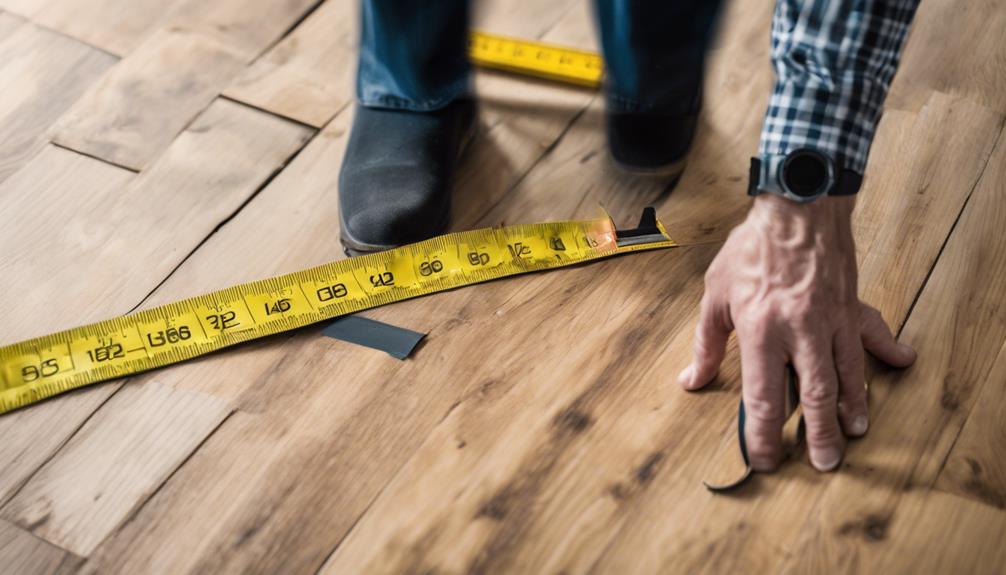
When measuring board thickness, our focus lies on the importance of this detail, ensuring precision for any future flooring work.
By using a ruler or caliper, we can accurately determine the thickness of each board.
It's crucial to record these dimensions meticulously for planning refinishing or repair projects.
Thickness Measurement Importance
To accurately assess the potential for refinishing a floor, it's essential to measure the thickness of the floorboards. Understanding the thickness of the flooring is crucial for determining its durability and the number of times it can be refinished.
Here are some key points highlighting the importance of measuring board thickness:
- Engineered wood floors can typically withstand 3-5 refinishing processes based on their wear layer thickness.
- Solid hardwood floors with a 3/4-inch thickness can endure 6-10 refinishing processes, showcasing their durability.
- Historical wood floors, especially those from before the 1920s, may only handle 2-3 refinishes due to their thinner construction.
- Performing a business card test can accurately measure the thickness of wood boards for refinishing purposes.
- Knowing the thickness helps in planning the refinishing process effectively to maintain the floor's integrity.
Tools for Accurate Measurements
Transitioning from understanding the importance of measuring board thickness, the accuracy of these measurements relies heavily on utilizing appropriate tools such as a digital caliper for precise readings. When measuring wood floor boards, a digital caliper ensures accuracy within 0.001 inches, allowing for detailed assessments.
It's crucial to measure the thickness at various points along the board to accommodate any irregularities present. Setting the caliper to the correct units, be it inches or millimeters, is paramount for consistent and reliable readings.
Recording Board Dimensions
Using a digital caliper or ruler, accurately measure the thickness of the board to determine its precise dimension. When recording board dimensions for flooring identification, consider the following:
- Measure the thickness of the board in inches or millimeters.
- Check for variations in thickness within the same flooring type or batch.
- Note any wear or damage on the board surface that may affect the overall thickness measurement.
- Record the thickness for accurate identification and replacement.
- Compare the measured thickness with manufacturer specifications or industry standards to ensure consistency.
Step 6: Examine Board Edges
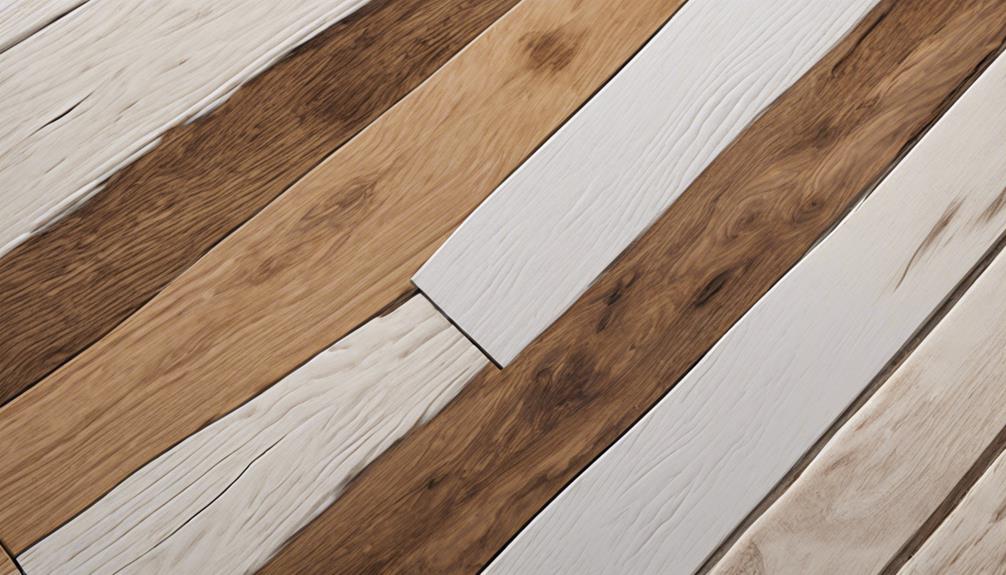
When examining board edges in the process of identifying floor boards, we focus on the presence of beveled or squared edges to determine the flooring style and design.
Beveled edges showcase a V-shaped groove along the edges, creating depth and visual interest on the edge of the floor. This style is often used to add a touch of elegance and sophistication to the flooring.
On the other hand, squared edges offer a clean and seamless look, making them suitable for modern and contemporary flooring designs. These edges provide a sleek finish to the edge of the floor, giving it a more polished appearance.
Step 7: Search for Nail Holes

As we proceed with our examination, our focus now shifts to scouring the floor boards for any telltale nail holes that may reveal crucial insights into the history and installation of the flooring. When searching for nail holes, it's essential to pay close attention to both the edges and surfaces of the floor boards. Here are some key points to consider:
- Look for nail holes along the edges or surface of the floor boards.
- Nail holes may indicate the original installation method or previous repairs.
- Nail holes can help determine if the boards were face-nailed or blind-nailed during installation.
- Counting the nail holes can give an idea of the board's age and history.
- Examining the nail holes closely can provide insights into the maintenance and wear of the floor boards.
Step 8: Test for Hardness
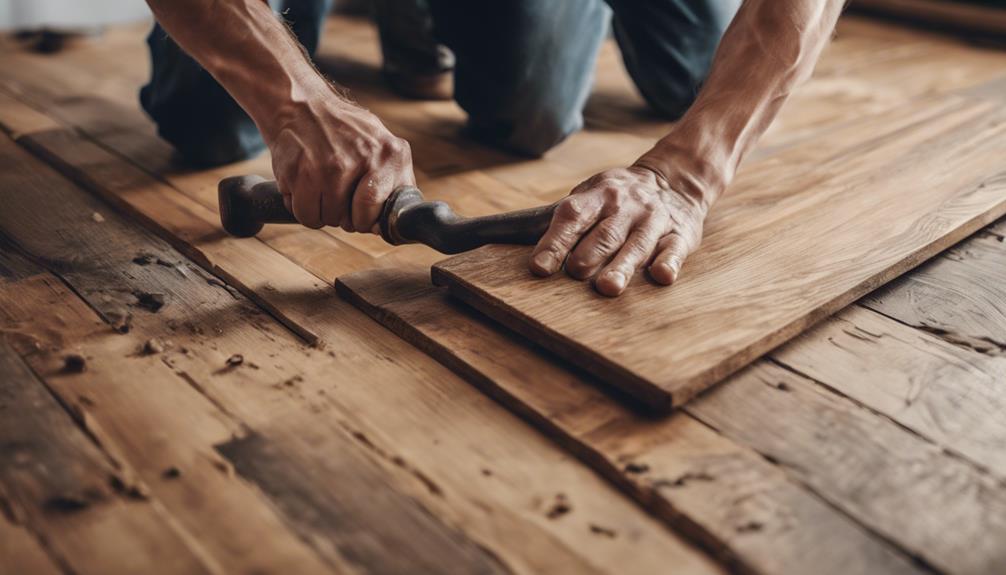
Let's assess the floor board's hardness by scratching the surface with a sharp object to determine its durability and quality. When testing the hardness of floor boards, it's essential to use a methodical approach. By running a sharp object along the surface, observe how the wood reacts. Softwood will show shallow scratches that are easily removed, indicating lower durability. In contrast, hardwood, like oak or maple, will resist the scratch, leaving a deep mark due to its dense and durable nature. Hardwood floors are renowned for their longevity and ability to withstand wear and tear over time.
Identifying hardwood floor boards through hardness testing is crucial in determining the overall quality and lifespan of the flooring. By understanding the hardness of the floor boards, homeowners can make informed decisions regarding maintenance and potential repairs. Remember, a deep scratch signifies hardwood, offering assurance of a sturdy and long-lasting flooring choice.
Step 9: Assess Board Lengths

To accurately evaluate the floor boards, measure and document the lengths of the removed boards for further analysis. By assessing the existing floor in detail, we can gain valuable insights into the condition of the boards and plan for any necessary repairs or replacements. Here are some key steps to consider when assessing board lengths:
- Measure and record the lengths of the boards removed to have accurate data for analysis.
- Check for any variations in board lengths to identify patterns or irregularities that may indicate issues with the floor.
- Note any boards that are significantly longer or shorter than the average length as these could be potential areas of concern.
- Assess if there's a consistent length pattern or if boards vary in size throughout the floor, which can help in understanding the overall condition of the flooring.
- Use the information gathered on board lengths to plan for replacements or repairs accordingly, ensuring a well-maintained and visually appealing floor.
Step 10: Verify Board Widths

Verifying board widths ensures consistency and a seamless appearance when replacing floorboards. When undertaking wood floor sanding and replacing damaged boards, it's crucial to measure the width of the replacement board accurately.
Confirm that the replacement board matches the width of the existing floorboards to maintain a uniform look. Using a replacement board that's wider or narrower than the surrounding boards can disrupt the flow and compromise the overall aesthetic of the flooring.
Consistent board widths are essential for achieving a professional finish and avoiding any gaps or unevenness in the floor surface.
Frequently Asked Questions
How Do I Identify Floor Boards?
We identify floorboards by examining:
- Wood species stamps
- Measuring width and thickness
- Checking color and grain patterns
- Assessing surface texture and finish
Consulting professionals or wood identification guides can provide accurate information.
How Do I Identify Flooring?
When identifying flooring, we focus on specific features like wood grain, color, and knots. Measuring the width, length, and thickness helps determine characteristics. Checking joints and patterns can match with known flooring types.
Examining edges and cuts aids in identifying the joint type used. Comparing overall appearance and quality to common wood flooring grades is crucial for accurate identification.
These steps assist in pinpointing the type of flooring in your space.
How Do I Identify Different Types of Wood Flooring?
When identifying different types of wood flooring, we assess the material's thickness, wear layer, and sanding capabilities. Solid hardwood floors, typically 3/4 inch thick, allow for more refinishes than engineered wood.
Look for layers in the cross-section to pinpoint engineered wood. The business card test helps determine floor thickness.
Pre-1920s floors can only withstand 2-3 refinishes. Remember to leave at least 1/8 inch for refinishing thin wood floors.
Is There an App to Identify Flooring?
Yes, there are apps available to identify flooring types. These apps leverage smartphone cameras to scan and analyze floors, providing details on material, color, and style.
Users can differentiate between hardwood, laminate, tile, or carpet effortlessly. Some apps even offer room measurement and layout planning features to enhance the flooring identification process.
Conclusion
In conclusion, by following these 10 simple steps to identify floorboards, you can become a wood flooring expert in no time.
Remember to pay attention to details like wood grain, knot holes, and board thickness to ensure a thorough assessment.
With a bit of practice and knowledge, you'll be able to spot quality floorboards and make necessary repairs with ease.
Happy flooring hunting!
- About the Author
- Latest Posts
Introducing Ron, the home decor aficionado at ByRetreat, whose passion for creating beautiful and inviting spaces is at the heart of his work. With his deep knowledge of home decor and his innate sense of style, Ron brings a wealth of expertise and a keen eye for detail to the ByRetreat team.
Ron’s love for home decor goes beyond aesthetics; he understands that our surroundings play a significant role in our overall well-being and productivity. With this in mind, Ron is dedicated to transforming remote workspaces into havens of comfort, functionality, and beauty.
Architecture Home Styles
How to Explore Native Houses in Indonesia
Catch a glimpse of Indonesia's cultural treasures through native houses, where each intricate detail holds a secret waiting to be discovered.

So, you think you've seen it all in Indonesia? Well, think again. Exploring native houses in this diverse archipelago offers a glimpse into a world where tradition meets craftsmanship in a harmonious blend.
From the intricate carvings to the unique architectural designs, each house tells a story waiting to be uncovered, inviting us to step into a realm where time seems to stand still.
But what lies beyond the façade of these cultural gems is a journey that promises to unravel the tapestry of Indonesia's rich heritage, revealing a side often overlooked by many travelers.
Key Takeaways
- Visit Batak, Toraja, and Joglo Houses for diverse architectural experiences.
- Discover intricate carvings and symbolic details in traditional Indonesian homes.
- Immerse in cultural heritage through communal spaces and ancient craftsmanship.
- Learn about Indonesia's rich history and values by exploring native houses.
Traditional Houses in Indonesia
In Indonesia, traditional houses embody rich cultural heritage through their unique architectural designs and symbolism. Among these remarkable dwellings, the boat-shaped houses stand out for their distinctive characteristics. The Batak House, found in certain regions, showcases intricate carvings and utilizes natural materials, reflecting a deep connection to the environment. These boat-shaped structures not only serve as homes but also as symbols of cultural identity and traditions passed down through generations.
The boat-shaped design of these traditional houses in Indonesia not only provides shelter but also represents a deeper meaning within the community. The intricate carvings on the Batak House, for example, tell stories of ancestry and spiritual beliefs, adding layers of significance to the architectural aesthetics. Through these boat-shaped dwellings, the indigenous peoples of Indonesia honor their heritage and preserve their cultural roots in a rapidly changing world.
Cultural Significance of Indigenous Dwellings

Exploring the intricate cultural significances embedded within indigenous dwellings in Indonesia unveils a tapestry of architectural symbolism and traditional values that resonate deeply within the communities they inhabit. These houses serve as more than mere shelters; they embody the cultural beliefs and practices of the diverse Indonesian tribes. The multi-generational living arrangements seen in houses like the Rumah Gadang in West Sumatra and the Rong Houses in Dayak communities highlight the importance of family and community ties in Indonesian society.
Moreover, the communal living spaces found in the Tongkonan House in Tana Toraja and the Uma Lulik in Timor foster a sense of togetherness and shared responsibilities among the inhabitants. Each architectural element, from the intricate carvings to the circular shapes and elevated stilts, holds deep symbolic meaning rooted in centuries-old traditions. These indigenous dwellings aren't just physical structures but living embodiments of Indonesia's rich cultural heritage, where every beam and wall tells a story of cultural continuity and communal harmony.
Top Native Houses to Visit
With intricate architectural designs and rich cultural symbolism, a journey to explore the top native houses in Indonesia promises a captivating immersion into the country's diverse heritage. Here are some of the top native houses you shouldn't miss:
| Native House | Features |
|---|---|
| Batak Houses | Boat-shaped roofs, intricate carvings, spaces for daily life activities like a living room and dining room. |
| Toraja Houses | Distinct saddleback roof design, used in ceremonies, areas for daily life such as a living room and dining room. |
| Joglo Houses | Elaborate wooden structures, symbolizing social hierarchy, with designated spaces for a living room and dining room. |
These native houses offer insights into the daily lives of the people inhabiting them. From the communal spaces like the living room where gatherings take place to the dining room where meals are shared, each house reflects the cultural practices and traditions of its respective community. Exploring these spaces provides a unique opportunity to understand the interconnectedness between architecture, daily life, and cultural identity in Indonesia.
Exploring Architectural Features

Amidst the vibrant tapestry of Indonesia's architectural landscape, one encounters a rich mosaic of cultural intricacies within the native houses that stand as living testaments to the country's diverse heritage. As we delve into exploring the architectural features of these remarkable dwellings, we're greeted by a fusion of craftsmanship and symbolism that captivates the senses:
- Boat-shaped roofs that gracefully mimic the curves of traditional Indonesian vessels, offering a nod to the nation's maritime history.
- Intricate carvings adorning the facades and interiors, telling stories of myths, legends, and ancestral wisdom.
- Wooden craftsmanship that showcases the mastery of artisans, each piece meticulously crafted to perfection.
- Natural materials seamlessly integrated into the structures, connecting the homes to the earth and reflecting a harmonious relationship with nature.
- Symbolic details embedded in every corner, from the layout to the decorations, embodying cultural beliefs and societal values passed down through generations.
Exploring these architectural marvels unveils a world where history, artistry, and tradition converge in a celebration of Indonesia's rich cultural heritage.
Immersing in Indonesian Hospitality
Immerse yourself in the captivating tapestry of traditional Indonesian hospitality by residing in native houses like the Batak House in North Sumatra or the Rumah Gadang in West Sumatra. These native houses not only offer a place to stay but also provide a gateway to the cultural heritage of Indonesia. The intricate carvings, boat-shaped roofs, and eco-friendly construction of these houses showcase the deep-rooted traditions and craftsmanship of the local communities.
Here is a table highlighting some of the unique aspects of traditional Indonesian hospitality found in native houses:
| Aspect | Description |
|---|---|
| Architectural Features | Intricate carvings, boat-shaped roofs |
| Social Significance | Symbolism of social hierarchy in houses like the Joglo House in Central Java |
| Eco-Friendly Construction | Use of sustainable materials like bamboo and thatch in houses like the Sasak House in Lombok |
| Spiritual Connections | Preservation of spiritual connections and communal living traditions in houses like the Uma Lulik in Timor or the Honai House in Papua |
| Local Way of Life | Experience the daily lives and customs of the local communities while staying in these native houses |
Staying in these native houses will not only provide you with a unique accommodation experience but also a deep dive into the rich tapestry of Indonesian traditions and hospitality.
Frequently Asked Questions
What Are Traditional Indonesian Houses Called?
Traditional Indonesian houses are called 'Rumah Adat.' These structures are more than just dwellings; they're living representations of Indonesia's rich cultural tapestry. Crafted from natural materials like wood and thatch, they stand as testaments to the country's diverse traditions.
Each region boasts its own unique design, influenced by local customs and beliefs. Exploring these native houses allows us to delve into the heart of Indonesia's vibrant heritage and architectural ingenuity.
What Is Indonesian Housing Like?
Indonesian housing embodies a rich tapestry of cultures and traditions, showcasing unique architecture and sustainable practices. From boat-shaped roofs to intricate carvings, these homes reflect a deep connection to nature and community.
Families often live together in multi-story structures, fostering bonds and kinship. Sustainability and cultural symbolism intertwine in Indonesian homes, creating a harmonious blend of functionality and heritage preservation.
Each dwelling tells a story of tradition, innovation, and unity.
What Is Typical Indonesian Housing?
We'll dive into the essence of typical Indonesian housing, showcasing the diverse array of styles like Batak, Toraja, Joglo, and more. These houses boast unique architectural features, reflecting the rich heritage of Indonesia's indigenous communities.
From intricate carvings to bamboo and thatch construction, each house tells a story of cultural significance and tradition. Multi-generational living arrangements further deepen the bond between people, highlighting the social and spiritual connections within the community.
What Is a House Called in Indonesia?
In Indonesia, a house is often referred to as a 'rumah' in Bahasa Indonesia. These structures aren't merely places of dwelling; they embody the essence of Indonesian culture and heritage.
Each region has its unique names for traditional houses, such as 'rumah adat' or 'rumah suku,' showcasing the diverse architectural styles and craftsmanship.
These homes serve as living monuments, reflecting the country's history, beliefs, and social structure.
Conclusion
In conclusion, exploring native houses in Indonesia is like taking a journey through a living museum of cultural heritage. Each traditional dwelling tells a story of the past and present, showcasing the craftsmanship and traditions of its people.
By immersing ourselves in these architectural wonders, we can truly appreciate the beauty and diversity of Indonesia's indigenous cultures. So, let's hit the road and dive into the rich tapestry of Indonesian history – the world is our oyster!
- About the Author
- Latest Posts
Introducing Ron, the home decor aficionado at ByRetreat, whose passion for creating beautiful and inviting spaces is at the heart of his work. With his deep knowledge of home decor and his innate sense of style, Ron brings a wealth of expertise and a keen eye for detail to the ByRetreat team.
Ron’s love for home decor goes beyond aesthetics; he understands that our surroundings play a significant role in our overall well-being and productivity. With this in mind, Ron is dedicated to transforming remote workspaces into havens of comfort, functionality, and beauty.
Architecture Home Styles
How Do You Mix Modern and Traditional Art Styles?
Balancing the fusion of modern and traditional art styles in a space can be a captivating challenge – want to know the secret?

When it comes to blending modern and traditional art styles, finding the perfect equilibrium can seem like an insurmountable task. However, by carefully curating a space that seamlessly fuses the two, the results can be awe-inspiring.
But how exactly can this be achieved? Stay tuned as we unravel the intricacies of merging these seemingly contrasting artistic realms to create a harmonious and captivating environment that speaks to the essence of both styles.
Key Takeaways
- Blend colors, materials, and shapes for a cohesive look.
- Establish harmony through shared textures and patterns.
- Use common color palettes and subtle details for cohesion.
- Integrate traditional and modern art for a stylish, effortless design.
Dominant Style Selection
Upon evaluating the home shell and architecture, we determine the dominant style by applying the 80/20 rule, allocating 80% for the primary style and 20% for the secondary style. To achieve a harmonious blend of modern and traditional design, we strategically place traditional pieces as the foundation, anchoring the space with their timeless elegance. Modern art with retro undertones can then be incorporated to infuse a touch of innovation and vitality. By integrating contemporary finds alongside vintage furniture, we create an eclectic yet cohesive overall look that seamlessly marries the two design styles.
Selecting the dominant style is crucial, as it sets the tone for the entire space. By opting for a mix of modern and traditional elements, we can strike a balance that's both refreshing and sophisticated. The key lies in seamlessly blending the two styles to create a visually stimulating environment that captivates the eye and sparks curiosity. When done thoughtfully, the fusion of modern and traditional design can result in a space that isn't only aesthetically pleasing but also rich in character and depth.
Harmony Vs. Contrast

After establishing the dominant style selection in a space blending modern and traditional art styles, the next crucial consideration is determining whether to prioritize harmony or contrast in the overall design approach. When mixing modern and traditional elements, the choice between harmony and contrast plays a significant role in the visual impact of the room.
| Harmony | Contrast |
|---|---|
| Evenly distribute elements from both styles | Use colors and materials to blend or contrast styles |
| Create a cohesive look | Achieve a bold and dynamic effect |
| Balance furniture choices for a calming harmony | Opt for striking contrasts to reflect personal style |
To achieve harmony, blend colors and materials seamlessly, integrating modern and traditional pieces throughout the room. Contrast, on the other hand, can be achieved by strategically placing items that diverge in style, color, or era. Whether aiming for a contemporary feel or a touch of vintage charm, the decision between harmony and contrast will define the overall aesthetic of the space.
Starting With Essential Pieces
We start the design process by focusing on selecting essential furniture pieces that will serve as the foundation for blending modern and traditional art styles in the room. It's crucial to establish a strong base with key elements such as traditional seating arrangements or larger units before introducing modern art pieces or contemporary furniture.
Sofas and tables play a vital role in setting the tone for the space, providing a canvas for layering different styles. When deciding on chairs, strategic placement can add personality and elevate the overall design. Narrowing down furniture choices based on the dominating style helps in determining whether to aim for harmony or contrast when mixing modern and traditional elements.
Tying Art Pieces Together

To achieve a cohesive blend of modern and traditional art styles in a space, the key lies in tying art pieces together through shared colors, shapes, textures, or patterns. When merging different art styles, it's essential to create visual harmony by incorporating common elements that bridge the gap between traditional and modern aesthetics.
Here are five strategies to unify art pieces effectively:
- Utilize a similar color palette: Using shared colors across traditional and modern artworks can create a cohesive appearance and tie the pieces together seamlessly.
- Focus on common shapes: Look for recurring shapes or forms in the art pieces to establish a visual connection and blend the styles cohesively.
- Consider shared textures: Incorporating similar textures in both traditional and modern art can enhance the overall visual cohesion of the space.
- Highlight recurring patterns: Identifying and emphasizing common patterns in the artworks can help unify them and create a harmonious look.
- Pay attention to subtle details: Small details in art pieces can play a significant role in blending traditional and modern styles, so focusing on these nuances is key to achieving a cohesive design.
Adding Final Touches
Incorporating strategic elements like velvet throw pillows and thoughtful lighting choices plays a crucial role in enhancing the fusion of modern and traditional art styles within a space. These final touches serve as the bridge that connects the two worlds, creating rooms that appear effortless and stylish. By mixing traditional and modern aesthetics with a neutral color palette, you can achieve a harmonious balance that's visually appealing.
When adding final touches, consider integrating a vintage piece of art alongside contemporary curves to add depth and character to the room. This juxtaposition of styles creates an eclectic atmosphere that's both intriguing and inviting. Combining modern and traditional styles in this manner allows for a seamless transition between the two, resulting in a space that feels cohesive and well-thought-out.
To master the art of mixing traditional and modern art styles, focus on layering textures, incorporating unexpected elements, and paying attention to the finer details. By following these design tips, you can transform your space into a great place to start experimenting with the fusion of vintage and contemporary art, ultimately achieving a look that's both timeless and fresh.
Frequently Asked Questions
Can You Mix Modern and Traditional Styles?
Yes, we can seamlessly blend modern and traditional styles to create a captivating fusion. By intertwining contemporary elements with classic artistry, we achieve a design that's both timeless and cutting-edge.
This harmonious marriage of old and new offers a fresh perspective and cultivates a rich visual tapestry. Embracing the juxtaposition of modern and traditional styles leads to an innovative approach that sparks creativity and intrigue in interior design.
How Do You Blend Traditional and Modern?
When blending traditional and modern art styles, we aim for a seamless integration that harmonizes the contrasting aesthetics. Finding commonalities in colors, shapes, and textures between the two styles is key.
What Is the Combination of Traditional and Modern Design Called?
The combination of traditional and modern design is known as 'Transitional' style. This aesthetic blends classic elements with contemporary features, creating a balanced and harmonious look.
It seamlessly integrates traditional and modern art pieces, offering a timeless and cohesive space. Transitional design emphasizes comfort, warmth, and simplicity with clean lines and a minimalistic approach.
It aims to merge elements from different eras to achieve a cohesive and innovative design.
How Do You Combine Different Art Styles?
When combining different art styles, we focus on harmony and contrast. By blending complementary colors and themes and experimenting with various mediums, we create a cohesive yet dynamic visual experience.
Symmetry and asymmetry play a crucial role in adding balance and interest to our art arrangements. Dominant styles serve as focal points, while contrasting ones add depth and dimension.
Ultimately, our goal is to personalize spaces and evoke a sense of creativity and innovation.
Conclusion
In conclusion, blending modern and traditional art styles is a delicate dance of balance and creativity. By carefully selecting a dominant style, harmonizing or contrasting elements, and layering essential pieces with unique art, textiles, lighting, and plants, a space can truly come to life.
Embracing imperfections and experimenting with unexpected themes adds depth and personality to the mix. The result? A visually captivating and harmonious fusion of the old and the new.
- About the Author
- Latest Posts
Introducing Ron, the home decor aficionado at ByRetreat, whose passion for creating beautiful and inviting spaces is at the heart of his work. With his deep knowledge of home decor and his innate sense of style, Ron brings a wealth of expertise and a keen eye for detail to the ByRetreat team.
Ron’s love for home decor goes beyond aesthetics; he understands that our surroundings play a significant role in our overall well-being and productivity. With this in mind, Ron is dedicated to transforming remote workspaces into havens of comfort, functionality, and beauty.
Architecture Home Styles
How to Have a Tiny Home in Arizona: Your Essential Guide
Fascinated by the idea of a tiny home in Arizona? Discover how tax considerations can impact your journey in this essential guide.
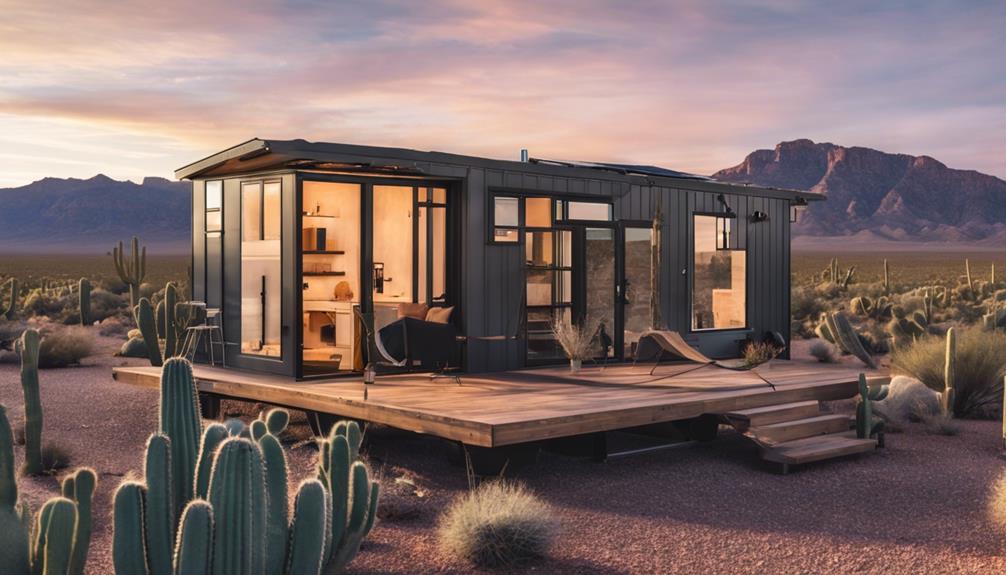
Embarking on the journey of having a tiny home in Arizona is like navigating through a desert oasis, each step revealing new insights and challenges. From understanding the intricate web of zoning laws to discovering the perfect location that aligns with your tiny living dreams, this essential guide equips you with the knowledge needed to turn your tiny home vision into reality.
But what about the unique tax considerations that come with owning a tiny home in Arizona? Stay tuned to uncover key insights that will make a difference in your tiny home journey.
Key Takeaways
- Understand Arizona zoning laws for placement in suitable zones.
- Seek permits for tiny homes based on location and structure type.
- Explore tax benefits for tiny homeowners through property tax exemptions.
- Build a supportive community through local groups and events for guidance.
Zoning Laws and Regulations in Arizona
When navigating the realm of tiny home living in Arizona, understanding the intricacies of zoning laws and regulations becomes paramount. In Arizona, zoning laws permit tiny houses on foundations in multifamily, detached single-family, and accessory dwelling unit zones.
However, for Tiny Homes on Wheels, they're typically classified as recreational vehicles and must adhere to specific parking regulations within designated zones. Maricopa County has established particular regulations for tiny houses, including constraints on the floor area allowed for permanent structures. On the other hand, Pima County imposes restrictions on Tiny Homes on Wheels through specific codes that govern their placement.
The zoning options for tiny houses in Arizona encompass various zones such as isolated single-family zones, accessory dwelling unit zones, and multifamily zones. Familiarizing oneself with these zoning laws and regulations is crucial for anyone considering embarking on the adventure of tiny home living in Arizona.
Ideal Locations for Tiny Homes
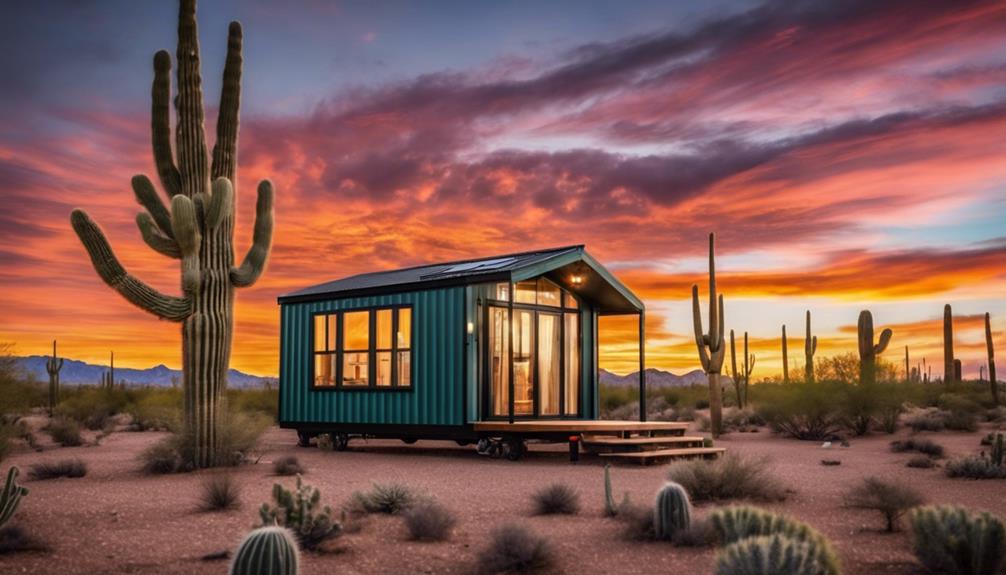
For those seeking ideal locations to establish their tiny homes in Arizona, cities like Phoenix, Tucson, Sedona, and Lakeside present attractive options. When considering where to set up your tiny home in Arizona, keep in mind that Pima County and Coconino County permit the establishment of tiny houses in specific zones. In these areas, tiny homes can be placed in isolated single-family zones, ADU zones, and multifamily zones. For those with tiny houses on wheels, it's important to note that they must be parked in designated R.V. zones in compliance with regulations.
- Phoenix, Tucson, Sedona, and Lakeside are ideal cities for setting up tiny homes in Arizona.
- Pima County and Coconino County allow tiny houses in specific zones.
- Tiny homes can be placed in single-family zones, ADU zones, and multifamily zones.
- Tiny houses on wheels must adhere to regulations in designated R.V. zones.
Tax Considerations for Tiny Home Owners
Exploring the tax implications of owning a tiny home in Arizona reveals potential benefits and considerations that can significantly impact financial planning for homeowners. Tiny home owners in Arizona may qualify for property tax exemptions based on factors like square footage and adherence to green building standards. Additionally, the size of tiny homes could lead to reduced property tax assessments in certain counties. It is crucial for Arizona tiny home owners to familiarize themselves with local tax laws to take advantage of any available tax benefits. Seeking guidance from a tax professional or local tax assessor can provide valuable insights into how owning a tiny home in Arizona may influence property taxes.
Tax Considerations for Tiny Home Owners:
| Key Points | Details | Importance |
|---|---|---|
| Property Tax Exemptions | Available based on square footage and green standards | Maximize Savings |
| Reduced Assessments | Smaller homes could mean lower tax bills | Financial Advantage |
| County Variances | Regulations differ, impacting tax benefits | Local Compliance |
| Professional Advice | Consult with tax professionals for guidance | Optimal Planning |
Finding Community Support in Arizona

By actively engaging with local resources and networking opportunities, tiny home enthusiasts in Arizona can establish a strong sense of community support to enhance their living experience.
Here are some ways to find community support in Arizona:
- Join local Facebook groups like 'Arizona Tiny House Community' for a supportive network.
- Attend tiny house meetups and events in Arizona to connect with like-minded individuals.
- Explore tiny house workshops and seminars in the state to gain knowledge and resources.
- Consider volunteering with non-profit organizations focused on sustainable living and tiny house advocacy in Arizona.
These opportunities not only provide a sense of belonging within the tiny house community but also offer valuable insights, resources, and support for those embracing the tiny home lifestyle in Arizona.
Engaging with these avenues can enrich your experience, foster connections, and empower you to navigate the challenges and joys of sustainable living in the state.
Building and Parking Tips for Tiny Homes
Engaging with the regulations and guidelines for building and parking tiny homes in Arizona is crucial for ensuring compliance and a smooth transition into sustainable living. Tiny homes on foundations in Arizona must adhere to the 2018 IRC Appendix Q requirements, which outline specific space dimensions and safety features to guarantee structural integrity.
Building a tiny home on skids offers a semi-permanent placement option while still allowing for mobility if relocation becomes necessary. For those opting for tiny homes on wheels, meeting mobile home requirements is essential, and a minimum of 160 square feet is required for parking.
The flexibility in setting up tiny homes in various zone types in Arizona provides diverse housing options based on individual preferences. Tiny houses on wheels are particularly popular for their mobility and flexibility, making them an attractive choice for those desiring a minimalist lifestyle without sacrificing comfort.
Frequently Asked Questions
Can I Put a Tiny House on My Property in Arizona?
Yes, we can put a tiny house on our property in Arizona if it complies with local zoning regulations. Different options like multifamily, detached single-family, or accessory dwelling units are available. Land near Maricopa City, Pinal County, offers accessible placement.
How Much Does a Tiny House Cost in Az?
Tiny houses in Arizona can range from $20,000 to $200,000 depending on size and customization. DIY kits start at $8,000, but labor costs add up. Land, utilities, and permits are extra. Building a tiny house can be a cost-effective housing choice.
What Is the Minimum Square Footage for a House in Arizona?
In Arizona, the minimum square footage for a house varies based on its foundation type. For tiny houses on foundations, it's 200 square feet, while those on trailers require at least 160 square feet. Adhering to building codes is essential.
Does Arizona Have a Tiny Home Community?
We do have tiny home communities in Arizona. These communities provide shared amenities, community engagement, and a supportive environment. Living in a tiny house community offers a unique sense of belonging, shared resources, and a close-knit experience.
Conclusion
In conclusion, navigating the world of tiny homes in Arizona may seem like a daunting task, but with the right resources and community support, it can be a breeze.
From zoning laws to building tips, we've covered it all in our essential guide.
So go ahead, take the leap into tiny home living and watch your dreams of a cozy, sustainable lifestyle come to life in the Grand Canyon State!
- About the Author
- Latest Posts
Introducing Ron, the home decor aficionado at ByRetreat, whose passion for creating beautiful and inviting spaces is at the heart of his work. With his deep knowledge of home decor and his innate sense of style, Ron brings a wealth of expertise and a keen eye for detail to the ByRetreat team.
Ron’s love for home decor goes beyond aesthetics; he understands that our surroundings play a significant role in our overall well-being and productivity. With this in mind, Ron is dedicated to transforming remote workspaces into havens of comfort, functionality, and beauty.
-

 Retreat5 days ago
Retreat5 days agoDIY Aromatherapy Diffusers for a Spa-Like Atmosphere at Home
-

 Retreat1 week ago
Retreat1 week agoThe Profitability of Retreat Centers: A Financial Analysis
-

 Retreat2 weeks ago
Retreat2 weeks agoComprehensive Review: Are Home Decorators Ceiling Fans Worth the Investment?
-

 Retreat1 week ago
Retreat1 week agoUnusual DIY Projects: Designing a Space Probe in Bitlife
-

 Retreat2 weeks ago
Retreat2 weeks agoStep-By-Step Tutorial: Reupholstering a Chair With Buttons
-

 Retreat6 days ago
Retreat6 days agoHow to Create a Zen Garden for Your Retreat Center
-

 Retreat1 week ago
Retreat1 week agoIs Opening a Home Decor Store Profitable in 2024?
-

 Retreat2 weeks ago
Retreat2 weeks agoThe Ultimate Guide to Baking Acrylic Paint on Ceramic Mugs































